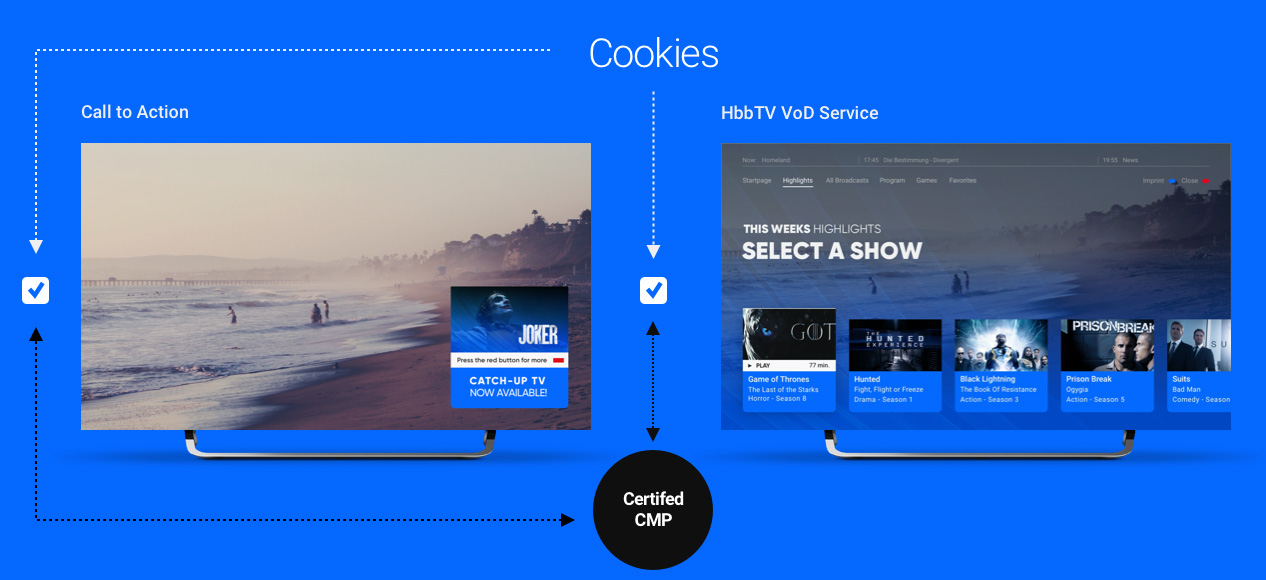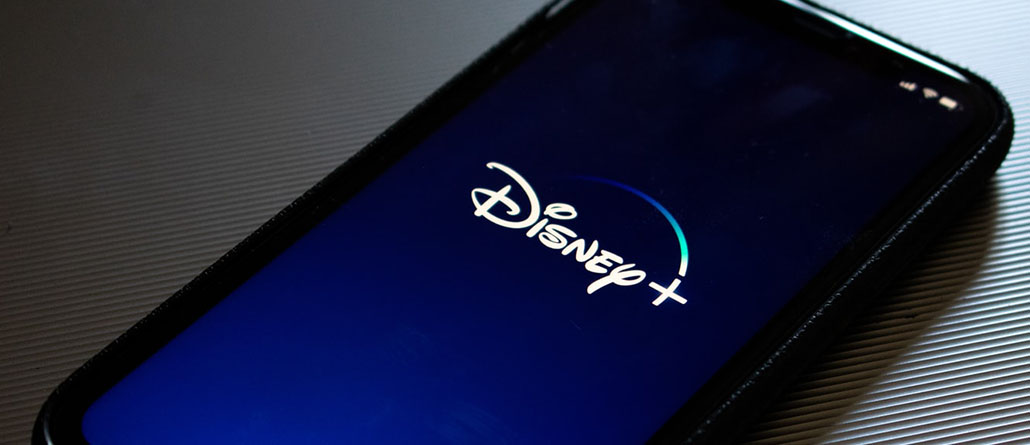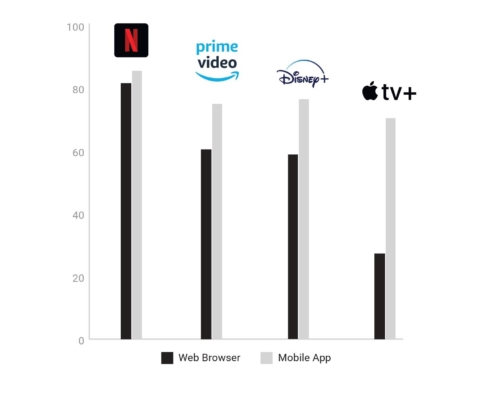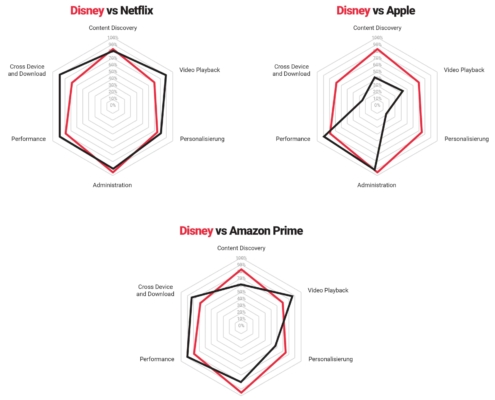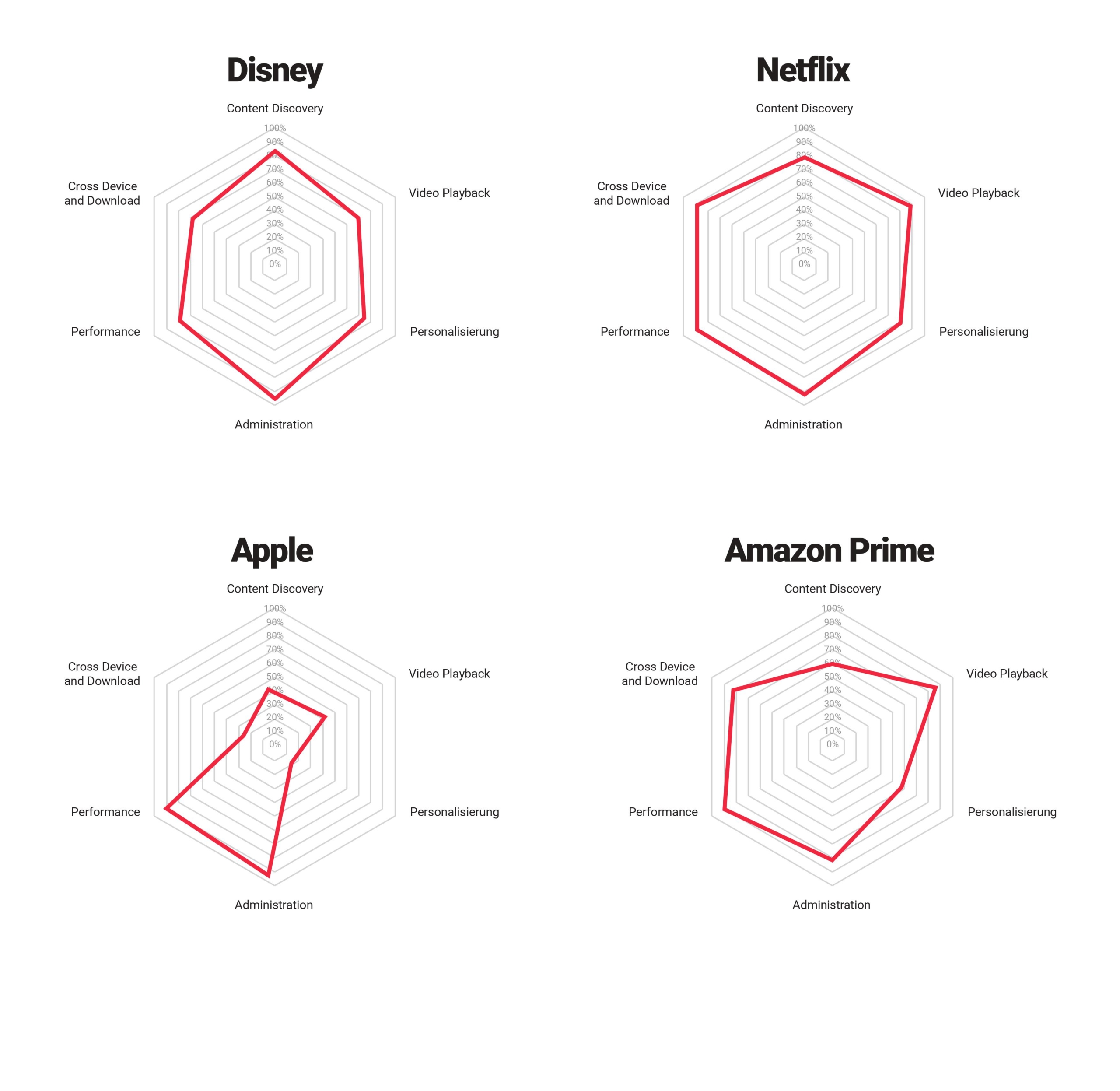TeraVolt GmbH is an owner-managed agency for enhanced TV, based in Hamburg, Germany. Founded in 2006, TeraVolt specializes in the development of pioneering digital TV experiences. The agency provides its customers with tailor-made solutions, from market-specific consultation to the creation and technical implementation of innovative products. Its product portfolio includes services, consultation, and applications in the areas of managed platforms, enhanced TV, monetization, and OTT. With its headquarters based in Hamburg, TeraVolt consists of a highly experienced management team and 45 strategy, product, and technology experts.
81 percent of the German TV stations offering content via HbbTV have not implemented a Consent Tool in their media libraries. Nevertheless, they have a proud market share of 78 percent. This is the result of an analysis by TeraVolt, in which the Hamburgers watched 48 stations offering HbbTV.
Hamburg, 23. Juli 2020 – Disney+ has room for improvement on Samsung's smart TV system, Tizen. The streaming service performs better on AndroidTV and Amazon's FireTV as well as AppleTV and LG's WebOS. That is the conclusion of a study conducted by TeraVolt.
Although the player of Disney+ works perfectly with Tizen (100%), the input (on screen keyboard) leaves a lot to be desired (68%). Moreover, there are problems with the performance (76%) and the usability (78%). For example, the log-in process proved to be complicated due to the non-intuitive keyboard. Within the application, long loading times of the preview images and jerky scrolling compromise the user experience.
In the case of Apple TV and Web OS, Disney+ was particularly convincing with its performance (100% each), discovery (Apple TV: 94%, Web OS: 100%), and its player (Apple TV: 98%, Web OS: 100%). The streaming service also reaches its highest score with its player for Amazon's Fire TV and Android TV (96% each) but loses ground when it comes to the search for particular content (67% each).
The fact that Disney+ performs relatively poorly on Tizen is problematic for both Samsung and Disney. According to an earlier study also conducted by TeraVolt, Tizen reaches up to six million households in Germany alone, with a market share in other European countries likely to be similar.
"Especially young users are hardly willing to compromise on functionality and might switch from Disney+ to Netflix to get better performance. And more affluent users may turn away from Samsung to enjoy Disney+ on a better-performing system. Either way, Samsung and Disney are the losers. It is important for both to catch up here," says Tobias Künkel, Managing Director at TeraVolt. "Actually, this is very unusual for Samsung. In our regular QA tests, Tizen always performs very well. With adjustments on a manageable scale, it would be easy to achieve significant improvements for Disney+".
About the study: For this ranking, TeraVolt looked at the performance (loading times, cross device usage, etc.), input (e.g., on screen keyboard) and usability (binge watching, accessibility, subtitles), as well as discovery (displaying relevant content, etc.), search, and player (reels, voice, etc.) of Disney+ on the different systems.
by Tobias Fröhlich
"See Corona as an opportunity" – many of you probably can't hear this sentence anymore. And I can understand you. If the Corona virus were indeed a chance, it would be called a Corona chance – not a Corona crisis. But we must come to terms with the new normal.
The best and most controversially discussed example: German professional football. In the last two weeks, the clubs of the first and second Bundesliga continued their leagues with games behind closed doors. There has been much discussion about the necessity of continuing, but one thing is certain: it will continue. One decisive factor is, however, missing: the fans.
During the past two weekends, we were able to observe how seriously their absence weighs. The game broadcast was reduced to what it actually is: football. No singing, no whistling concerts, no pictures of crowds of people holding each other in their arms after a winning goal in the 90th minute.
And this state of affairs will by no means remain confined to the current season. We're talking about restrictions that will last until the end of the year, maybe even well into next year. Until a vaccine is found, produced, and distributed on a large scale.
Sky has responded
The pay-TV channel Sky has already responded to this: The Munich-based company offers its customers using the Sky Q or Sky+ receiver the option of fan chants and crowd noise as a sound option. A top match on Saturday evening was also commentated on by one fan from each team. Additionally, augmented reality was increasingly used to integrate statistics, graphics, and online voting.
This is exactly the right approach. But it is only the tip of the iceberg, because it´s still done by the broadcaster with nearly no influence from the fans. Let's be honest: The Corona crisis is currently revealing many gaps that have existed for a long time anyway. People, and especially the younger target groups, are consuming differently nowadays. They want to participate, become broadcasters themselves and be heard. For many football fans in particular, it is important to make a statement and leave their mark on what is happening. Be it the holding up of the scarf during the club anthem, a choreography when the players run in, or the protest against the very unpopular Monday games.
All that is now gone. And I share the concern of the fans that they will lose their voice. That's why we have to compensate for this loss with the digital possibilities available to us. We can offer the fans a new platform, give them back their entertainment, and preserve parts of their fan culture. In short, we can create a digital fan experience.
1. Every game is a home game
Each game could be a home game for every fan, with each of them having a fan commentary and a personalized home game backdrop with appropriate fan chants. These are arranged by the fans themselves, just like in a stadium. They alone decide when and what is played. During the course of the match, all the fans of a team could then participate live on TV and decide which fan chant they would like to hear next. They could react to certain game situations with emojis, flags, or gifs and exchange information about what is happening. The whole thing would be a similar concept to the popular live streams on Instagram, YouTube, or Twitch. It's not without reason that such models are especially popular with young viewers, as they convey a feeling of togetherness, of watching and exchanging together. Once again: This is not the "real deal" you get in the stadium, but the fans can at least get involved digitally and help shape the whole thing.
2. Together with club legends on the "digital grandstand”
Netflix has demonstrated how to watch movies and series together despite the quarantine with its Party Mode. This model could also be transferred to the Bundesliga experience on TV and even expanded. What if I could watch the games of my favorite team together with a legendary player or coach? In concrete terms, this would mean that I could follow his facial expressions, reactions, and comments live via the picture-in-picture option. Sport 1 has already demonstrated this in the past with its "Fantalk" format. This would be just the next logical step. It would create entirely new marketing options for the clubs. They will need these above all when next season's matches are also held without an audience, and they are missing out on a lot of money.
3. The digital premium package
... that would at least go a little beyond the boundaries of the digital. With such a package, for example, one could cooperate with delivery services to deliver stadium sausage and beer directly to the fans' living rooms. In cooperation with the clubs, the broadcasters could create and play exclusive content for premium users. For example, a match analysis with the coach. Cooperation with the clubs is the real trick for the broadcasters. Because the clubs can provide them with exclusive access to their fans, as well as to season ticket and box owners, and can compensate them for lost income.
There are no limits to the wealth of ideas in the digital fan experience. But you should always include the fans. As in any other good product development, "customer centricity" is the nucleus. But in order to do this, the fans must come out of their sometimes counterproductive antipathy and ask themselves whether they want to give up football for 12 to 18 months or whether they want to help shape it instead. The digital has come to stay: Corona is a green playground where everyone can get involved.
The opportunity lies in the digital
These are only three possibilities for a digital fan experience in football. The decisive factor with all three ideas is that they merely present a possibility, so every viewer is free to choose whether or not to use them.
From a purely sports-journalistic point of view, Sky provides a very good product with its football offering. But fans don't always want that. Sometimes they just want to let go, get emotional, and let their passion for football run wild. Of course, this is best done live in the stadium. But if this opportunity is lost, we have to offer them a digital alternative that makes up for it as much as possible.
The Corona virus is a catalyst with which we can overcome digital deficits faster and thus create a completely new user experience on the TV set at home.
Foto: Kon Karampelas (Unsplash)
Hamburg, 19 March 2020 – Netflix in front of Disney and Amazon: The video-on-demand platform Disney+ will have as good a user experience as Amazon Prime Video at its German launch on March 24. However, the mouse company is still a long way from the industry heavyweight Netflix. This is the result of a large-scale study by TeraVolt GmbH, in which they analyzed various streaming services in 28 categories for their user experience.
In this study, Netflix scored 83 out of a total of 100 possible points, followed by Amazon Prime Video (68) and Disney+ (67.5). The streaming service Apple TV+, which was only launched in November, is lagging behind with only 49 points.
Disney+ scores particularly well in administration, which includes the management of login data and subscriptions. Here, Disney achieves 95 percent. Content discovery (83%), for example, the presentation of content and autoplay, as well as personalization (74%), and performance (79%), are also in a very good range for newcomers. However, there is a backlog in demand for video playback (69%) and cross-device use and downloads (68%). As a result, Disney+ is on a par with Netflix only in the administration and content discovery clusters, but clearly lags behind in all others. On the other hand, Disney leaves at least Amazon Prime Video behind in terms of personalization and content discovery.
In its study, TeraVolt examined and compared a total of eight streaming services. The German and European services Joyn and SKY were successful, but could not keep up with the budgets of American companies. Nevertheless, the performance of Joyn was particularly noteworthy. The young streaming service scored particularly well in terms of administration, but also in terms of performance, explains TeraVolt managing director Tobias Fröhlich: "Joyn has only been on the market for just under a year, and Prosieben.Sat.1, unlike Netflix or Amazon, has only limited financial possibilities. Taking these circumstances into account, Joyn is doing well and has created a great perspective for the future. Sky has also done a lot for the user experience in the past few years, but in comparison, it still has some catching up to do."
The clear loser of the study is Apple TV+. This is particularly bitter for the company that was once a showcase for usability. For example, in the areas of cross-device use, downloads, and personalization, Apple leaves its users unsupported unless they are using the service on an Apple device. But perhaps that is also a business strategy to boost hardware sales.
About the methodology: TeraVolt subjected each of the streaming services to a practical test and evaluated them according to 28 different criteria that can be assigned to the superordinate categories of performance, content discovery, video playback, cross-device and download, administration, and personalization. The results refer to the desktop version in the Internet browser or the respective smartphone app.

